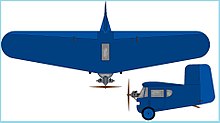Mihail Stabiloplan
The Stabiloplan III construction, created in 1927 by the Romanian inventor Filip Mihail (1896–1962), had a span of 9 m and was equipped with a so-called auto-stable profile. It was controlled by a wing with ailerons that could be adjusted relative to the fuselage axis and a large damped rudder. Thus, the control around the transverse axis corresponded roughly to that of today's trikes .
The small two - cylinder boxer engine was installed semi-concealed in front of the pilot, who therefore had no direct view ahead. The wings could be folded back for easier storage in a garage. The axis of the landing gear was mounted almost in the plane of rotation of the propeller to protect it and prevent rollover. Presumably, the entire device for road transport could also be hitched backwards to a car with a drawbar. Not much is known about the flight performance of the Stabiloplan III, but it may have been a bit underpowered.
The next construction, Stabiloplan IV , also had a span of 9 m and was equipped with an autostable profile. Compared to the previous model from 1927, it represented a considerable improvement. The two-cylinder boxer ABC Scorpion engine with 40 hp was still hung in front of the windshield without disguising. Control was now carried out via continuous elevons and a large damped rudder. In addition, the wing could be moved lengthways for trimming purposes.
During a demonstration flight in 1935 , the pilot Lucien Levi crossed the Carpathian Mountains for the first time from Bucharest to Brașov and back. The cruising speed was about 180 km / h in 3000 m, which is very remarkable for a light aircraft of the time.
literature
- Rudolf Storck among others: Flying Wings. The historical development of the world's tailless and flying wing aircraft. Bernard and Graefe, Bonn 2003, ISBN 3-7637-6242-6 .

